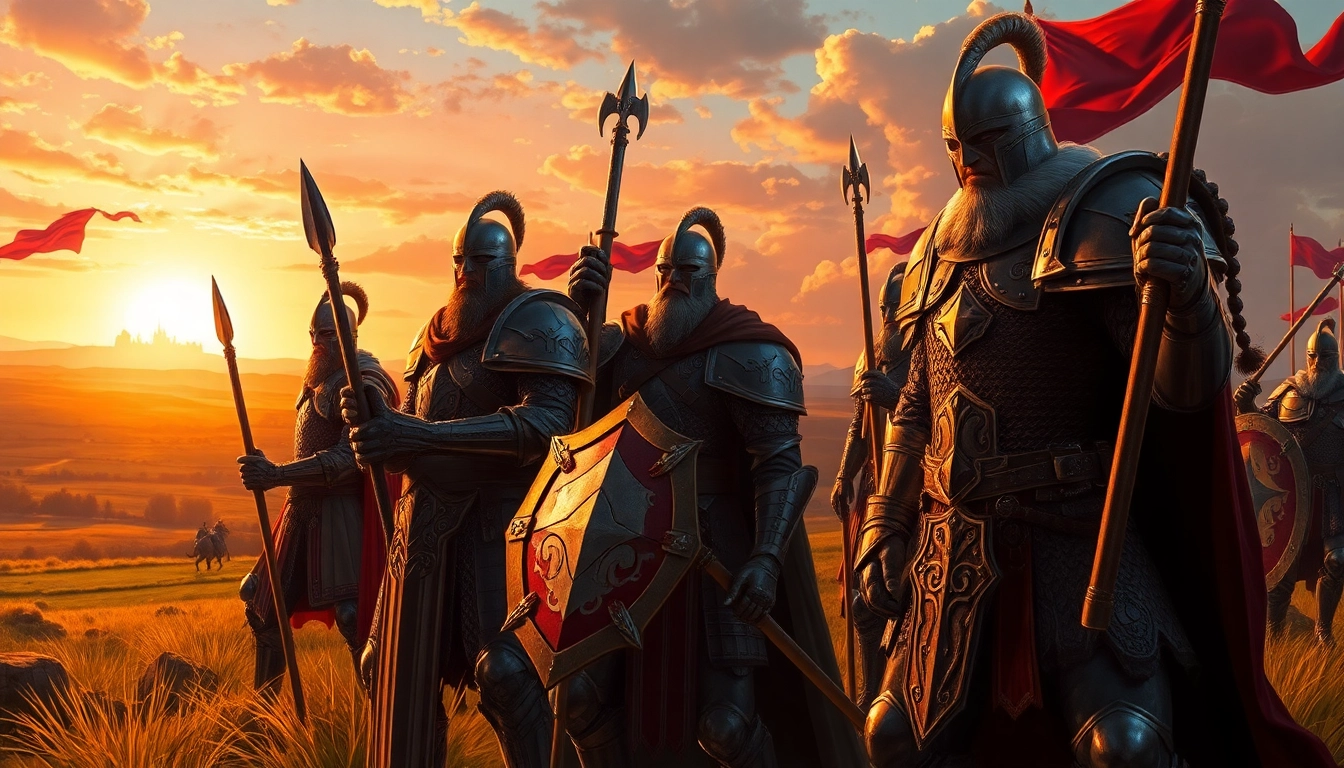Understanding Warlords: The Essence of Leadership
The concept of the warlords transcends time and geography, embodying the attributes of leadership, strategic acumen, and the art of war. These figures have shaped the course of history by their sheer will and military prowess, leading their followers to victory against great odds. This exploration into the essence of warlords not only touches upon their historical significance but also unpacks the character traits and strategic mindset inherent to successful leadership in warfare.
Defining Warlords in Historical Context
The term “warlord” typically refers to a military leader who exercises power independently, often within a larger political framework. Historically, warlords emerged during periods when centralized authority was weak or fragmented. For instance, during the Warring States period in ancient China, warlords ruled over specific territories and engaged in continuous conflict for supremacy. In Europe, feudal lords wielded substantial military power, commanding their vassals in service of a king or their own ambitions.
Key Characteristics of Effective Warlords
Effective warlords share several key characteristics that set them apart from mere military commanders. First among these is their capability to inspire loyalty among their troops. Through charisma, vision, and demonstration of ferocity in battle, they build an unshakeable bond with their followers. Furthermore, astute warlords possess a nuanced understanding of warfare — they analyze battlefield conditions and adapt to changing circumstances, utilizing their resources carefully. Strategic foresight is also crucial; successful warlords often anticipate their opponent’s moves and counteract them effectively.
The Role of Strategy and Tactics
Strategy is an overarching blueprint that dictates long-term objectives in warfare, while tactics are the specific methods employed on the battlefield. Warlords orchestrate their campaigns through a blend of innovative strategy and tactical execution. Historical examples abound, such as Genghis Khan, whose unique strategies, such as the feigned retreat, enabled him to outmaneuver and outsmart larger armies. Understanding the difference between these two aspects is essential for anyone aspiring to embody the persona of a warlord in any context — historical or gameplay.
Different Types of Warlords Across Cultures
As the nature of warfare has evolved, so too have the archetypes of warlords. Different cultures have produced unique warlords with distinct tactics and cultural significance. This section explores the various representations of warlords globally, providing examples from European, Asian, and Indigenous contexts.
The European Feudal Warlord
In medieval Europe, the feudal system birthed a class of warlords known as lords or barons. These figures held significant sway over land and military resources. A notable example is William the Conqueror, who utilized both political maneuvering and military might to establish himself as the first Norman King of England. His victory at the Battle of Hastings in 1066 exemplifies the strategic prowess expected of a feudal warlord.
Aspects of Asian Warlord Culture
Asia boasts a rich historical tapestry of warlords, particularly in China and Japan. In ancient China, warlords during the Warring States period exemplified the complexities of military governance. Meanwhile, Japanese daimyōs and samurai engineered feudalism throughout the country, each vying for land and prestige through warfare and alliances. The code of bushido espoused by samurai highlights loyalty, honor, and martial prowess, shaping the cultural narrative surrounding Japanese warlords.
Influences of Indigenous Warlords
Indigenous cultures also feature warlords of their own, often linked to tribal leadership roles. Figures like Tecumseh, a prominent Shawnee leader, symbolize resistance against colonization efforts in North America. His ability to unite various tribes showcases how indigenous warlords navigated complex social and political landscapes to pursue common goals. These leaders are often driven by a sense of responsibility to their people and cultural preservation, setting them apart from conventional notions of warlords driven purely by conquest.
Crafting Your Warlord Persona in Gameplay
Emulating the spirit of a warlord in gameplay requires strategic thinking, team dynamics, and psychological insight. This section delves into how gamers can cultivate their warlord persona, integrating leadership traits and tactical awareness into their gaming experience.
Choosing the Right Attributes and Skills
In many games, players can customize their characters through a selection of attributes and skills. When crafting a warlord, consider traits such as charisma for inspiring allies, strength for rallying troops in battle, and intelligence for strategic planning. Each attribute can influence gameplay significantly, with the right blend creating a formidable leader capable of turning the tides of battle.
Leveraging Psychological Tactics
The psychological aspect of warfare cannot be overstated. Warlords often utilized deception, intimidation, and propaganda to gain advantages over their opponents. In games, players can implement similar tactics by understanding their opponents’ behaviors and exploiting weaknesses. For instance, feigning vulnerability can draw enemies into traps, allowing cunning leaders to exploit the situation.
Enhancing Performance Through Team Dynamics
Effective warlords are not lone wolves; they understand the value of collaboration. In multiplayer games, fostering strong team dynamics improves overall performance. Communication is key — articulating strategies, rallying troops, and recognizing individual strengths within the team will enhance collective efficacy. Skills such as conflict resolution and motivational leadership can also ensure team cohesion under pressure.
Battlefield Techniques: What Every Warlord Should Know
Every warlord worth their salt must possess a repertoire of battlefield techniques. This section examines essential strategies that every aspiring warlord should be well-versed in to ensure success in gaming and theoretical warfare alike.
Formation Strategies for Maximum Impact
Throughout history, formations have played a critical role in warfare. The traditional phalanx, Roman legions, and cavalry flanks each serve as inspiration for gamers today. Learning to deploy your forces effectively, maintaining flexibility to adapt formations to changing conditions, and utilizing natural terrain can provide a significant upper hand in battles.
Resource Allocation in Warfare
At the heart of any successful campaign lies resource management. Understanding when to allocate troops, supplies, and special skills can determine victory or defeat. Players must assess their resources continuously, balancing offense and defense while scouting the battlefield for opportunities to gain an upper hand over opponents.
Adapting to Opponent’s Tactics
The best warlords are skilled enemies of change. Assessing and interpreting an opponent’s tactics requires keen observation and foresight. Adaptation may mean altering attack patterns, adjusting unit compositions, or utilizing counter-tactics effectively. This dynamic aspect of gameplay promotes a competitive edge, allowing a player to anticipate and respond strategically as situations evolve on the battlefield.
Case Studies: Legendary Warlords in History
An examination of historical figureheads enriches the understanding of what it means to be a warlord. By analyzing the successes and failures of legendary commanders, modern players can glean valuable lessons applicable to their strategic gameplay.
Military Strategies of Notable Historical Warlords
From Hannibal’s bold crossing of the Alps to Napoleon’s blitzkrieg tactics, historical warlords have employed diverse strategies to achieve remarkable victories. Analyzing their approaches, including their use of terrain, surprise maneuvers, and psychological warfare, can provide gamers with insight into tactical flexibility and innovative thinking that can be replicated in modern gaming.
Lessons from Iconic Battles
Iconic battles such as the Battle of Waterloo and the Siege of Vicksburg hold rich lessons on the consequences of miscalculated moves and the power of unity and perseverance. Each conflict contains details about resource management, troop morale, and the importance of intelligence-gathering. Understanding these battles enables aspiring warlords to appreciate the numerous factors that can lead to triumph or disaster.
Applying Historical Insights to Modern Gameplay
Adapting the invaluable insights gleaned from historical case studies enhances the gaming experience. Players can emulate strategies used by historical figures, modify them to fit the gaming context, and develop their unique methods. Successful warlords in both history and gameplay must remain fluid and capable of evolving their strategies to meet the challenges that lie ahead.



